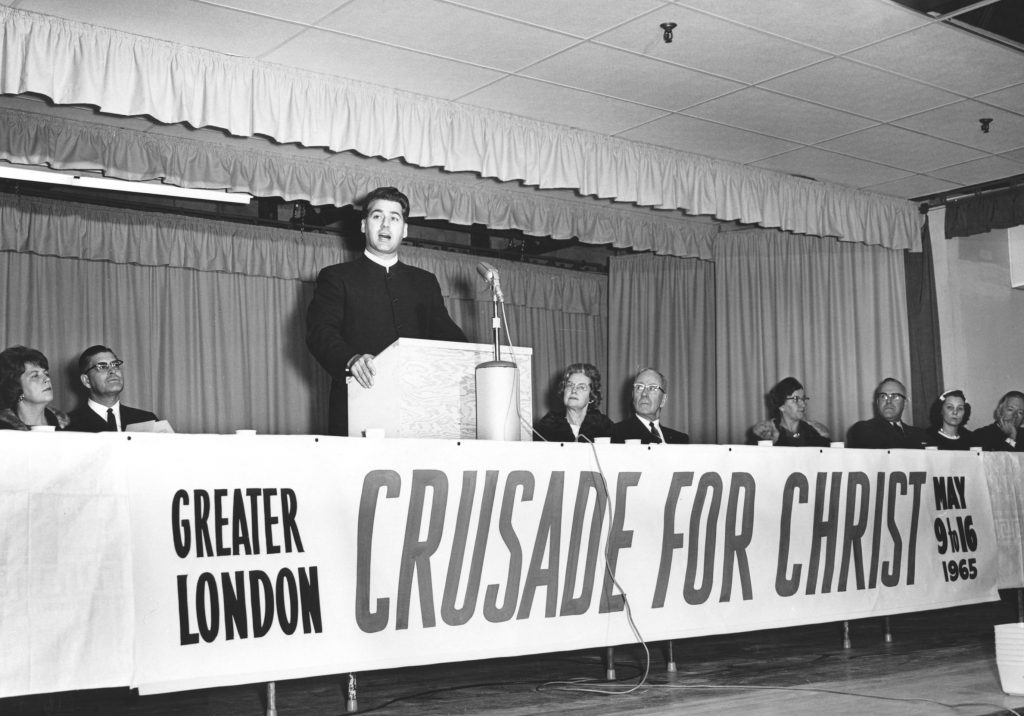Evangelist Billy Graham died Feb. 21, 2018. Myron Augsburger was the fifth president of what was then Eastern Mennonite College & Seminary, serving from 1965 to 1980. He was also professor of theology from 1963 to 1980. The following article first appeared in the March 12 edition of the Mennonite World Review and is republished here with permission.
Myron Augsburger admired Billy Graham but didn’t take his advice.
It was about 1950 or ’51 when the aspiring Mennonite evangelist first talked to Graham — already well on his way to becoming “America’s preacher” — at a meeting of the National Association of Evangelicals in Minneapolis.
Though still in his early 20s, Augsburger was already thinking about whether Mennonites ought to be doing more with mass evangelism.
Graham, 11 years his senior, was a rising star who would within a decade transform old-fashioned revival meetings into mass media events that filled civic arenas, then stadiums, and eventually reach worldwide television audiences.
What advice would he give a young Mennonite preacher who hoped to be heard beyond his humble denomination?
Graham’s counsel: “Get rid of that coat!”
Augsburger’s coat was of the type called “plain,” without lapels, as was expected to be worn by men, especially preachers, in the “old” Mennonite Church at that time.
How did Augsburger reply?
“I think I just said that my message is more than my expression in attire,” he said in a phone interview from his home in Harrisonburg, Va., on Feb. 23, two days after Graham died at the age of 99.
Augsburger would continue to wear the plain coat into the late 1970s, while serving as president of Eastern Mennonite College, long after most other Mennonite Church men had given up that marker of nonconformity.
That long-ago meeting of two young evangelists makes a good story, Augsburger observed, but far more significant to him was one about 30 years later, in the early 1980s.
By then pastoring in Washington, D.C., Augsburger was called upon to introduce Graham at a service there. As Augsburger recalls, the globe-trotting spiritual adviser to presidents stepped up to the microphone and said, “Now, I’m not a pacifist like Myron here, but I have become a nuclear pacifist. There is no way we can nuke the Russians in the spirit of Jesus.”
Later, in the home of Augsburger and his wife, Esther, they discussed peace and nonviolence at greater length.
“He came to affirm this for the church but not for the state,” Augsburger said of Graham’s view of nonviolence. “Billy took a much more conciliatory approach than many evangelicals.”
Inspiring evangelists
At 88, Augsburger still maintains an active schedule of speaking and travel. Looking back more than 60 years, Graham’s example inspired him and other Mennonite itinerant revivalists, like George R. Brunk II and Howard Hammer, in the 1950s, the heyday of mass evangelism.
It wasn’t just Graham’s ability to draw big crowds that impressed them.
“We were encouraged by his ecumenical example,” Augsburger said. “We were impressed that he could work beyond his own circles.”
Mennonites had a long way to go in that regard. To get people from different Mennonite branches together under one revival tent “was as revolutionary as we could be right then,” he said.
Suspicions among Christian denominations have faded since the days when Graham, a Baptist, was criticized by more conservative evangelicals for working with Catholics and liberal Protestants. But in other ways, the divisions among Christians, often drawn along political lines, are stronger than ever, Augsburger believes.
Today, the religious boundaries being crossed are as likely to be interfaith as within the Christian faith. This presents a different set of challenges.
“My perception is that we lack clarity in how to talk with people of other religions,” Augsburger said. “The danger is that we minimize Jesus rather than present what Jesus has to offer.”
To Augsburger, the key is respect without compromise.
“While we can respect the values of Islam, we have to emphasize the uniqueness of Jesus,” Augsburger said. “We need to rediscover the primacy of the gospel, so that our ethics come out of walking with Jesus.”
He believes Graham’s example of bridge-building is relevant today.
“He modeled interdenominational respect, and that needs to happen in a fresh way,” Augsburger said.
